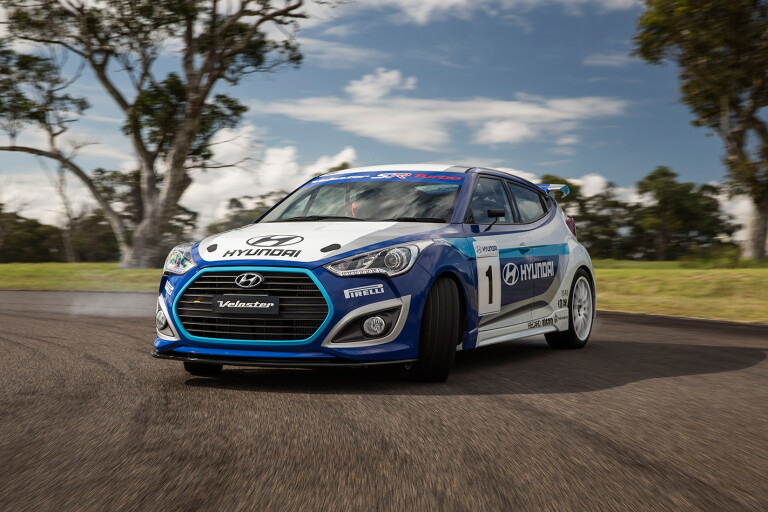
The angry rasp filling the cabin offers a strong clue that this isn't your typical Hyundai.
Mind you, if you hadn't noticed by now that this Veloster Turbo is something out of the ordinary, you're probably not fit to be driving a car in the first place.
The driver's seat is a hip-hugging bucket, which you're squeezed into by a five-point harness. In front of you is a deeply dished suede steering wheel, while a complex FIA-spec roll cage fills the space behind. The Veloster Race Concept has been created by Hyundai Australia to test how far its quirky coupe-cum-hatch can be pushed, and MOTOR is lucky enough to be one of the first behind the wheel.
The car was completed in late-2012 but it's taken almost 18 months for it to turn a wheel in anger. Beyond the obvious motorsport stuff, which makes it eligible for anything up to Asia-Pacific Rally Championship level, the car is relatively stock, by race car standards at least.
A retuned ECU and high-flow exhaust system lift the 1.6-litre turbo four-cylinder to around 190kW/320Nm, a hefty increase over the standard car's 150kW/265Nm. A Cusco 1-way limited-slip diff helps put the power to the ground, as do the sticky Pirelli P Zero Trofeo semi slicks.
Keeping those tyres in contact with the tarmac is a set of DMS four-way adjustable shocks while large Alcon brakes – 355mm rotors with four-pot calipers up front, 300mm units with two-pot calipers at the rear – sit behind 18 x 8.0-inch Team Dynamics wheels.
Given so much of the car is standard, getting off the mark is free of any typical race-car histrionics. The seat is set further back than ideal but time is tight so it'll just have to do. Joining the circuit reveals steering that is lighter than standard and an engine that is definitely more urgent than the road car.
The first lap is exploratory to allow the tyres to come up to temperature but despite being warned by Hyundai WRC driver Chris Atkinson, the non-power assisted brakes still cause a moment of mild panic when pressing the middle pedal with normal pressure produces a loud squealing from the race-specs pads but not much in the way of retardation.
This Veloster on steroids has had little attention in terms of suspension setup, but it feels safe and secure straight out of the box, much like the standard car. Grip levels on these tyres are obviously a lot higher, and the LSD finds great drive out of corners. Its aggressive take-up would be a step too far in a road car, but works well here.
Once accustomed to the pressure required, the brakes provide excellent feel and plenty of stopping power, too. The engine is probably more effective if short-shifted around the 6000rpm mark, but stretch to 6500rpm and you're rewarded with an addictive 'CRACK' on upshifts.
Throughout the day suspension tweaks are trialled to help mobilise the rear and get the car to turn in better, as it's easy to over-drive the car and lose time through understeer. Much more time is needed to arrive at the ideal balance, and there's also a shudder under heavy braking that needs to be sorted, but that's all part of the development process.
Future plans for the car are yet to be finalised, but don't be surprised to see the Veloster Race Concept at a tarmac rally or two in 2015.
Specs
Engine 1591cc inline-4, DOHC, 16v, turbocharger
Power 190kW*
Torque 320Nm*
Weight 1265kg*
0-100km/h 6.0sec*
Top Speed 230km/h*
Price N/A
*all figures estimates

COMMENTS